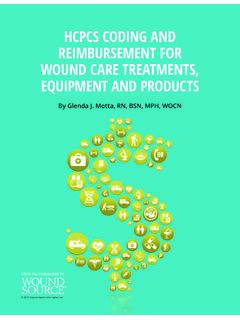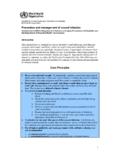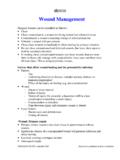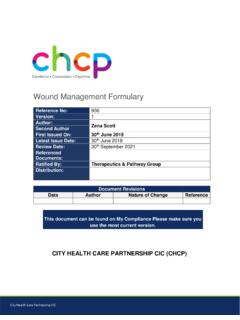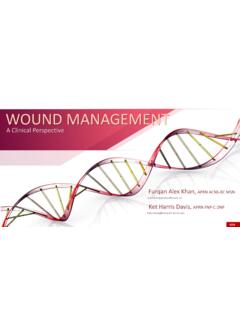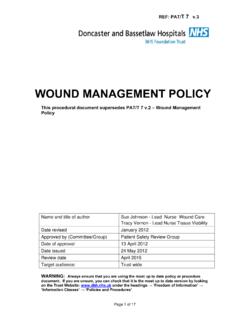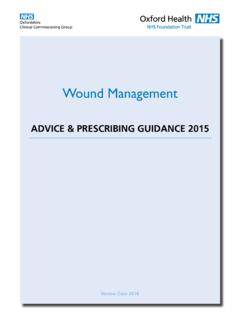Transcription of Surgical Wound Management - WoundSource
1 Wound Infection Diagnosis and Management / 2018 Kestrel Health Information, Inc. / 1 A part ofO C TO B E R 2018 Surgical Wound Management : A Guide to Post-Operative Wound CareCopyright 2018 WoundSource & Kestrel Health Information, Inc. All rights PART OFEducation to improve your practiceSPONSORED BYWound Infection Diagnosis and Management / 2018 Kestrel Health Information, Inc. / 2 A part ofSurgical Wound Management : A Guide to Post-Operative Wound CareIntroduction and BackgroundMillions of patients undergo Surgical procedures every year. Advances in Surgical techniques afford patients increased access to minimally invasive techniques, allowing avoidance of the need for traditional open Surgical incisions.
2 However, many procedures performed may still require a larger incision or may involve an existing open Wound of varying chronicity. Failure to heal, including Wound dehiscence and Surgical site infections (SSIs), is the most common major complication related to Surgical Wound Management , and monitoring for conditions related to this failure is crucial during the immediate (three- to four-week) post-operative impact of SSI is widespread, affecting the patient, caregivers, the treatment team, and the health care system as a whole. SSIs are challenging because of their multifactorial development. For patients who go on to develop SSI after a Surgical procedure, length of stay can be increased by up to two weeks, and overall treatment costs average nearly $35,000 per incident.
3 The most common Wound -related consequence of SSI is dehiscence, for which Wound Management modalities such as debridement and advanced dressings may be used to expedite Wound Management : A Guide to Post-Operative Wound Care Copyright 2018 WoundSource & Kestrel Health Information, Inc. All rights A PART OFWound Infection Diagnosis and Management / 2018 Kestrel Health Information, Inc. / 3 A part ofClassification of Surgical WoundsSurgical wounds are classified by the degree of contaminants present. Classification allows for appropriate risk stratification and assists with guiding appropriate treatment:1 CLASS I/CLEAN:Uninfected, uninflamed, generally closed primarily; no entry into respiratory, gastrointestinal, or genitourinary tracts ( , mastectomy or splenectomy).
4 CLASS II/CLEAN-CONTAMINATED: Controlled entry into respiratory, gastrointestinal, or genitourinary tracts ( , cholecystectomy, bronchoscopy).CLASS III/CONTAMINATED: Open, fresh, accidental wounds; operations with a major breach in sterile technique, gross spillage from the gastrointestinal tract, and acute noninfectious inflammation ( , bile spillage in cholecystectomy, rectal procedures).CLASS IV/DIRTY-INFECTED: Old trauma or wounds with devitalized tissue, existing infection, or perforation, where organisms were present before operation ( , incision and drainage, chronic Wound debridement).3 Surgical Wound Management : A Guide to Post-Operative Wound Care Copyright 2018 WoundSource & Kestrel Health Information, Inc.
5 All rights A PART OF Surgical wounds are classified by the degree of contaminants present. Wound Infection Diagnosis and Management / 2018 Kestrel Health Information, Inc. / 4 A part of4 Surgical Wound Management : A Guide to Post-Operative Wound Care Copyright 2018 WoundSource & Kestrel Health Information, Inc. All rights A PART OFSurgical Wound HealingSurgical wounds heal via one of three mechanisms: primary, secondary, or tertiary intention. 1 Primary Intention Healing involves layered closure, ameliorating any dead space that could contribute to hematoma/seroma formation, followed by approximation of Wound edges and closure using synthetic adhesives, sutures, or staples.
6 Examples of healing by primary intention include closure of an uncontaminated laceration or biopsy, plastic/reconstructive procedures, or closure of other class I/clean Surgical wounds. The goal of this type of closure, often referred to as primary closure, is complete functional healing. Closure inside the golden period of eight hours after initial incision is recommended because outside this timeframe the Wound can be exposed to substantial bioburden and other contaminants and may have edema precluding complete approximation of Wound 2 Secondary Intention Wounds with edges that are not linear, do not approximate, or are not able to be evaluated during the golden period may be left to heal by secondary intention.
7 This healing method is often utilized for wounds that are otherwise at risk for dehiscence secondary to overall poor patient condition ( , sepsis) or substantial Wound contamination ( , gross fecal contamination after bowel perforation) or wounds subject to excessive tension, such as areas over articulating Tertiary Intention Tertiary intention involves staged closure of a Wound ; the Wound may have been surgically created or of other etiology without previous treatment. Tertiary intention is also referred to as delayed primary closure because some Surgical incisions may be left open because of excessive contamination or infection, requiring debridement of non-viable tissue followed by a period of close monitoring to ensure appropriate perfusion and tissue viability before final Traumatic injuries involving vascular damage and subsequent alteration in tissue perfusion such as crush injuries are often treated in this manner, as are tissue or muscle flaps used to provide coverage for soft tissue defects.
8 Closure inside the golden period of eight hours after initial incision is Wound Infection Diagnosis and Management / 2018 Kestrel Health Information, Inc. / 5 A part of5 Surgical Wound Management : A Guide to Post-Operative Wound Care Copyright 2018 WoundSource & Kestrel Health Information, Inc. All rights A PART OFRisk Factors for Surgical Site InfectionsFew formal studies regarding risk factors in SSI have been conducted, so data is limited. This situation is further confounded by the fact that most SSIs occur after discharge, and patients present at varying stages of SSI development. The American College of Surgeons (ACS) performed a review of nearly 50,000 Surgical procedures and revealed that major contributors to SSI development included the following: dependent functional status; obesity; emergency nature, complexity, or longer duration of Surgical procedure; respiratory conditions limiting perfusion; diabetes; smoking; coronary artery and peripheral vascular disease; coagulopathy; female sex, and pre-operative Another review performed by the Veterans Affairs Surgical Quality Improvement Program including approximately 350,000 Surgical procedures revealed a SSI development rate within 30 days.
9 Most prominent noted risk factors included more advanced Wound classification, chemotherapy, smoking, radiation therapy, long-term corticosteroid use, and unintentional weight multitude of factors can affect Wound healing in the post-operative period. Identifying impediments to healing can lead to their minimization or even elimination. The following is not an exhaustive list, but rather a review of conditions that can negatively affect Wound healing in the Surgical patient tissue perfusion:Vascular disease and respiratory disorders can cause lack of oxygenated blood flow to the area of the tissue:Non-viable tissue will cause excessive inflammation in the Wound with subsequent host response, including delayed or infection:The presence of pathogens can cause abscess formation, Wound dehiscence, breakdown leading to evisceration of abdominal incisions, and ultimately stress during healing.
10 Shearing forces caused by excessive patient movement, including coughing, sneezing, vomiting, or exceeding prescribed lifting or activity restrictions, can contribute to tissue breakdown, or they can perpetuate edema, prolong the inflammatory period, and delay further tissue proliferation required for complete , including cancer and chemotherapeutic agents: Patients taking chemotherapeutic agents or therapeutic immunosuppressive medications and patients with disease states that predispose them to an immunosuppressed state are at increased SSI riskDiabetes mellitus: High hemoglobin A1c values are not independent predictors of SSI risk, and there is no current evidence to demonstrate that improvement of hemoglobin A1c levels decreases SSI risk.
